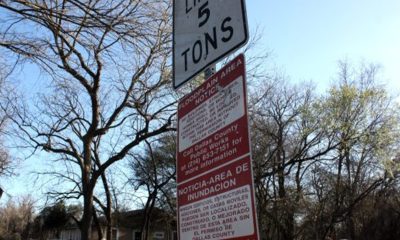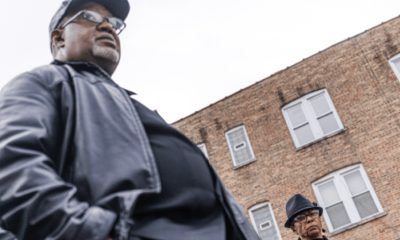Black History
Local legend referee excelled in more than sports
MINNESOTA SPOKESMAN-RECORDER — It’s been said that any two people on Earth are at least six acquaintance links apart. James “Jim” Robinson is no exception. The late Bill McMoore first hired Robinson, then a St. Paul high-schooler, to referee games at Hallie Q. Brown. McMoore, as Minneapolis Public Schools athletic director in the early 1980s, gave me my first high school basketball coaching job in Minnesota.
The late Bill McMoore first hired Robinson, then a St. Paul high-schooler, to referee games at Hallie Q. Brown. McMoore, as Minneapolis Public Schools athletic director in the early 1980s, gave me my first high school basketball coaching job in Minnesota.
Ed Prohofsky, who succeeded McMoore as MPS AD, saw me attending local basketball coaching clinics and told McMoore about me. Both he and Robinson sit together at Minnesota Timberwolves and Lynx games, and this columnist purposely pays his respects to these two elders.
After high school, Robinson was convinced by the late James Griffin, St. Paul’s first Black deputy fire chief, to pursue officiating as a second career and began to ref all over the state of Minnesota. I got to know Griffin, who along with Jimmy Lee was one of the first Black officials in Minnesota. He often advised me on my writing.
I first met Robinson when the late Kwame McDonald, a colleague, mentor and friend, introduced us at the summer league he ran and asked me to coach in the late 1980s. McDonald once coached Lisa Lissimore, the Minneapolis Public Schools(MSHSL) associate director, on the Summit-University women’s basketball team.
Lissimore recommended Robinson for one of the seven NCAA Living Legend awards handed out during the Men’s Final Four in April. She included a Black History Month piece I wrote in 2018 as part of her supporting documentation.
If you’re keeping count, that’s five degrees of separation of James Robinson, the first Black official to referee in the Minnesota State Boys’ Basketball Tournament in the 1970s; in total, he worked seven state tournaments. He refereed both football and basketball for many years in the Twin Cities and throughout Minnesota, then focused solely on hoops both at the high school and college levels.
The Big Ten selected Robinson in 1971 as a basketball official, and he became one of the first Black referees to work Division I sports. He worked Big Ten, Division I, II, and III games for 16 years before a knee injury forced him to retire. He then became a supervisor of officials both for the Big Ten and as MSHSL high school basketball officials coordinator and supervisor ever since.
A longtime advocate for Black officials, Robinson for many years has held officiating camps, helped found a minority officials association in Minnesota, and was a National Federation of Basketball Rules Writing Committee member.
During the late 1960s, local community folk approached Robinson to apply for the director of the Summit University Teen Center, which was developing a new social services concept, the “drop-in center.” He has now been at “The Loft” since 1967.
What I didn’t know about Robinson was that he is a master barber and served on the Minnesota Board of Barber Examiners. I later learned that as a youngster growing up in St. Paul he was the first Black elected as the citywide student chief of the school patrol boys, and as a teenager was selected to attend Minnesota’s Boys State where his peers selected him “Mayor of Boy’s State.”
Robinson’s impressive resume includes inductions into the Minnesota Basketball Coaches Association Hall of Honor and the MSHSL Hall of Fame.
“Who determines a legend?” Robinson, ever modest, responded when asked where the NCAA Living Legend honor ranks. “I would not rank [myself] so high.”
This article originally appeared in the Minnesota Spokesman-Recorder.
Activism
Oakland Post: Week of April 17 – 23, 2024
The printed Weekly Edition of the Oakland Post: Week of April 17 – 23, 2024

To enlarge your view of this issue, use the slider, magnifying glass icon or full page icon in the lower right corner of the browser window. ![]()
Black History
Matthew Henson: Explorer Extraordinaire
Matthew Henson, a trailblazing explorer who overcame countless obstacles to leave an incredible mark on history. Born on August 8, 1866, in Charles County, Maryland, his journey is a testament to the power of determination and the spirit of adventure.

By Tamara Shiloh
Matthew Henson, a trailblazing explorer who overcame countless obstacles to leave an incredible mark on history. Born on August 8, 1866, in Charles County, Maryland, his journey is a testament to the power of determination and the spirit of adventure.
Henson’s life began amidst the backdrop of post-Civil War America, where opportunities for African Americans were scarce. From a young age, he possessed an insatiable curiosity about the world beyond his small town. At the age of 12, he embarked on a journey that would change the course of his life forever when he joined a merchant ship as a cabin boy.
His most famous expedition was his journey to the Arctic with renowned explorer Robert E. Peary. In 1887, Henson joined Peary’s crew as a seaman and quickly proved himself to be invaluable with his skills as a navigator and craftsman. Over the course of several expeditions, Matthew endured extreme cold, treacherous terrain, and grueling conditions as he and Peary sought to reach the elusive North Pole.
In 1908–09, Peary set out on his eighth attempt to reach the North Pole. It was a big expedition, with Peary planning to leave supplies along the way. When he and Henson boarded their ship, the Roosevelt, leaving Greenland on August 18, 1909, they were joined by a large group. This included 22 Inuit men, 17 Inuit women, 10 children, 246 dogs, 70 tons of whale meat, blubber from 50 walruses, hunting gear, and tons of coal.
In February, Henson and Peary left their anchored ship at Ellesmere Island’s Cape Sheridan, along with the Inuit men and 130 dogs. They worked together to set up a trail and supplies along the way to the Pole.
Peary picked Henson and four Inuit people to join him in the final push to the Pole. However, before they reached their destination, Peary couldn’t walk anymore and had to ride in a dog sled. He sent Henson ahead to scout the way. In a later interview with a newspaper, Henson recalled being in the lead and realizing they had gone too far. The group turned back, and Henson noticed his footprints helped guide them to their destination. At that location, Henson planted the American flag.
Henson’s legacy extends far beyond his expeditions to the Arctic. He shattered racial barriers in the world of exploration and inspired countless individuals, regardless of race, to dream big and pursue their passions. In 1937, he was finally recognized for his achievements when he was inducted into The Explorers Club, an organization dedicated to promoting scientific exploration and field research.
Matthew Henson died in the Bronx, New York, on March 9, 1955, at the age of 88.
Art
Marin County: A Snapshot of California’s Black History Is on Display
The Marin County Office of Education, located at 1111 Las Gallinas Ave in San Rafael, will host the extraordinary exhibit, “The Legacy of Marin City: A California Black History Story (1942-1960),” from Feb. 1 to May 31, 2024. The interactive, historical, and immersive exhibit featuring memorabilia from Black shipyard workers who migrated from the South to the West Coast to work at the Marinship shipyard will provide an enriching experience for students and school staff. Community organizations will also be invited to tour the exhibit.

By Post Staff
The Marin County Office of Education, located at 1111 Las Gallinas Ave in San Rafael, will host the extraordinary exhibit, “The Legacy of Marin City: A California Black History Story (1942-1960),” from Feb. 1 to May 31, 2024.
The interactive, historical, and immersive exhibit featuring memorabilia from Black shipyard workers who migrated from the South to the West Coast to work at the Marinship shipyard will provide an enriching experience for students and school staff. Community organizations will also be invited to tour the exhibit.
All will have the opportunity to visit and be guided by its curator Felecia Gaston.
The exhibit will include photographs, articles and artifacts about the Black experience in Marin City from 1942 to 1960 from the Felecia Gaston Collection, the Anne T. Kent California Room Collection, The Ruth Marion and Pirkle Jones Collection, The Bancroft Library, and the Daniel Ruark Collection.
It also features contemporary original artwork by Chuck D of the Rock and Roll Hall of Fame group Public Enemy, clay sculptures by San Francisco-based artist Kaytea Petro, and art pieces made by Marin City youth in collaboration with Lynn Sondag, Associate Professor of Art at Dominican University of California.
The exhibit explores how Marin City residents endured housing inequities over the years and captures the history of plans to remove Black residents from the area after World War II. Throughout, it embodies the spirit of survival and endurance that emboldened the people who made Marin City home.
Felecia Gaston is the author of the commemorative book, ‘A Brand New Start…This is Home: The Story of World War II Marinship and the Legacy of Marin City.’ Thanks to the generous contribution of benefactors, a set of Felecia’s book will be placed in every public elementary, middle, and high school library in Marin.
In addition, educators and librarians at each school will have the opportunity to engage with Felecia in a review of best practices for utilizing the valuable primary sources within the book.
“Our goal is to provide students with the opportunity to learn from these significant and historical contributions to Marin County, California, and the United States,” said John Carroll, Marin County Superintendent of Schools.
“By engaging with Felecia’s book and then visiting the exhibit, students will be able to further connect their knowledge and gain a deeper understanding of this significant historical period,” Carroll continued.
Felecia Gaston adds, “The Marin County Office of Education’s decision to bring the Marin City Historical Traveling Exhibit and publication, ‘A Brand New Start…This is Home’ to young students is intentional and plays a substantial role in the educational world. It is imperative that our community knows the contributions of Marin City Black residents to Marin County. Our youth are best placed to lead this transformation.”
The Marin County Office of Education will host an Open House Reception of the exhibit’s debut on Feb. 1 from 4 p.m. – 6 p.m.. All school staff, educators, librarians, and community members are encouraged to attend to preview the exhibit and connect with Felecia Gaston. To contact Gaston, email MarinCityLegacy@marinschools.org
-

 Activism4 weeks ago
Activism4 weeks agoOakland Post: Week of March 27 – April 2, 2024
-

 #NNPA BlackPress4 weeks ago
#NNPA BlackPress4 weeks agoCOMMENTARY: D.C. Crime Bill Fails to Address Root Causes of Violence and Incarceration
-

 #NNPA BlackPress4 weeks ago
#NNPA BlackPress4 weeks agoFrom Raids to Revelations: The Dark Turn in Sean ‘Diddy’ Combs’ Saga
-

 #NNPA BlackPress4 weeks ago
#NNPA BlackPress4 weeks agoCOMMENTARY: Lady Day and The Lights!
-

 #NNPA BlackPress4 weeks ago
#NNPA BlackPress4 weeks agoMayor, City Council President React to May 31 Closing of Birmingham-Southern College
-

 #NNPA BlackPress4 weeks ago
#NNPA BlackPress4 weeks agoBaltimore Key Bridge Catastrophe: A City’s Heartbreak and a Nation’s Alarm
-

 #NNPA BlackPress4 weeks ago
#NNPA BlackPress4 weeks agoBaltimore’s Key Bridge Struck by Ship, Collapses into Water
-

 #NNPA BlackPress4 weeks ago
#NNPA BlackPress4 weeks agoBeloved Actor and Activist Louis Cameron Gossett Jr. Dies at 87














































